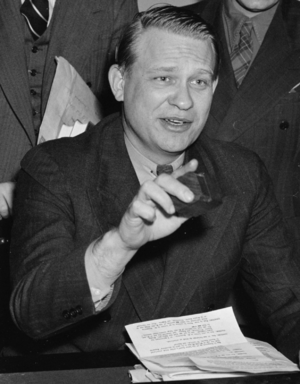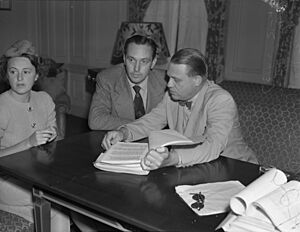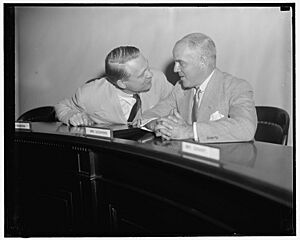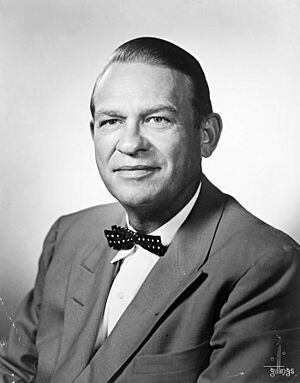Martin Dies Jr. facts for kids
Quick facts for kids
Martin Dies Jr.
|
|
|---|---|

Dies chairing a 1938 meeting of the
House Un-American Activities Committee |
|
| Member of the U.S. House of Representatives from Texas |
|
| In office March 4, 1931 – January 3, 1945 |
|
| Preceded by | John Calvin Box |
| Succeeded by | Jesse Martin Combs |
| Constituency | 2nd district |
| In office January 3, 1953 – January 3, 1959 |
|
| Preceded by | district created |
| Succeeded by | district abolished |
| Constituency | At-large district |
| Chairman of the House Committee Investigating Un-American Activities | |
| In office 1938–1944 |
|
| Preceded by | office established |
| Succeeded by | Edward J. Hart |
| Personal details | |
| Born | November 5, 1900 Colorado City, Texas, U.S. |
| Died | November 14, 1972 (aged 72) Lufkin, Texas, U.S. |
| Political party | Democratic |
| Spouse |
Myrtle McAdams
(m. 1920) |
| Children | 3, including Martin Dies Jr. |
| Parents |
|
| Alma mater | University of Texas National University School of Law (LLB) |
| Occupation |
|
Martin Dies Jr. (born November 5, 1900 – died November 14, 1972) was an important American politician from Texas. He was a member of the Democratic Party. Dies served many terms in the United States House of Representatives. He was first elected in 1931 and served until 1945. Later, he was elected again in 1953 and served until 1959.
Dies is best known for being the first chairman of a special committee. This committee was called the Special Committee to Investigate Un-American Activities. He led this committee from 1937 to 1944. The committee investigated groups and people thought to be "un-American."
Contents
Early Life and Education
Martin Dies Jr. was born in Colorado City, Texas, on November 5, 1900. His father, Martin Dies Sr., was also a politician. His father served in the U.S. House of Representatives from 1909 to 1919.
Martin Dies Jr. went to the University of Texas. He later earned a law degree from the National University School of Law in Washington, D.C.
Political Journey
After finishing his studies, Dies worked as a lawyer in Texas. He practiced law in Marshall, Texas and Orange, Texas. Later, he became a district judge.
In 1931, Dies was elected to the United States House of Representatives. He represented Texas's 2nd District. This was the same district his father had represented. This made him a second-generation U.S. Congressman.
At first, Dies supported the New Deal. This was a series of programs created by President Franklin D. Roosevelt. The New Deal aimed to help people during the Great Depression. Dies supported it because it helped the rural areas he represented. However, he later changed his mind. He became less supportive as labor unions gained more power in politics.
Leading the Un-American Activities Committee
In 1938, Martin Dies Jr. became the first chairman of the Special Committee to Investigate Un-American Activities. This committee was often called the "Dies Committee." He led it for seven years, until 1944.
The committee's main goal was to investigate groups and individuals. They looked into those believed to be working against American interests. Dies focused on finding people he thought were communists or fascists. He was often in the news because of his work on the committee.
Investigating Different Groups
The Dies Committee investigated various groups. They looked into German American groups linked to Nazi activities. They also investigated the Ku Klux Klan. Some members of the committee were hesitant to investigate the Klan. However, Dies himself criticized the Klan's anti-Catholic views.
Dies also looked into labor unions and some government agencies. He even wrote a book about his investigations called The Trojan Horse of America (1940).
Hollywood and Public Attention
The Dies Committee gained a lot of public attention. In 1938, the committee was criticized for including child star Shirley Temple on a list. She was only 10 years old at the time. Her name appeared on a list of Hollywood figures who sent greetings to a French newspaper. This newspaper was thought to be linked to communists.
Government officials, like Harold L. Ickes and Frances Perkins, spoke out. They said it was unfair to include Shirley Temple. The committee explained that they were only showing how some groups used famous names for their own purposes. They did not claim Shirley Temple was a communist.

Dies faced criticism for using the committee to oppose the New Deal. For example, Michigan Governor Frank Murphy lost his election after being called a "Communist dupe" during committee testimony. President Roosevelt said this was an unfair attempt to influence an election.
Dies was also concerned about minimum wage laws. He believed different wages should be set for different races.
After 1941, when the USSR became an ally against the Nazis, Dies continued to focus on finding communist spies. This was a time when the U.S. was fighting in World War II. His focus on communists was similar to the later McCarthyism era in the 1950s.
Later Years
Dies tried to become a U.S. Senator in 1941 but was not successful. He finished fourth in the election.
He retired from the House of Representatives in 1944. However, he was reelected to the House in 1952. He served again until 1959. In 1957, he ran for the Senate again but did not win.
Dies was one of the politicians who signed the Southern Manifesto in 1956. This document opposed the desegregation of public schools. This was ordered by the Supreme Court in the Brown v. Board of Education case.
After leaving Congress in 1959, Dies returned to Texas to practice law.
Family and Death
In 1920, Martin Dies Jr. married Myrtle McAdams. They had three sons: Robert, Jack, and Martin Jr.. His son, Martin Jr., also became a politician in Texas.
Martin Dies Jr. passed away on November 14, 1972, at the age of 72. He died from what appeared to be a heart attack.
See also
- List of members of the House Un-American Activities Committee
- List of United States representatives from Texas




